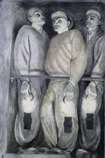 |
 |
The Miners |
|
 |
Sassu thus entered the European
debate open at that time between realists and formalists. In Paris the querelle du
réalisme was going on, with contributions by artists and men of letters on the theme
of an art which returns to the subject and rediscovers man, while in London Antony Blunt
took a similar position, in opposition to Cubists, abstract artists, Surrealists, and in
generalto the developments of the historical avant-gardes. |
 |
 |
The Strike |
|
 |
This choice on Sassu’s part
was reflected in the works dealing with contemporary society, starting with The
Big Café and later The
Marthyrs of Piazzale Loreto, and continued
with particular intensity in the years after World War II, when the confrontation between
realism and formalism emerged also in Italy. Works
belonging to this phase of Sassu’s painting are in particular those on the theme of
work (Miners,
1951; the series of The Tuna Kill and the port of
Savona, of the early 1950s: The Hong Kong Coolie, 1956); those on a political theme
(The
Strike, 1956: Il comizio, 1957; The Battle of Dien Bien Phu,
1957) and the series of paintings inspired by African American spirituals (Little David,
1961). |

